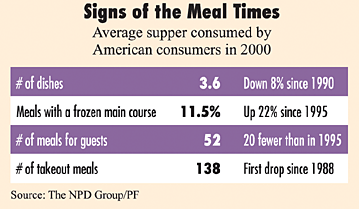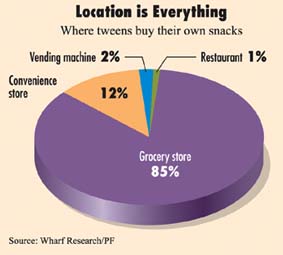Signs of the Times
In the sixteenth annual edition of itsReport on Eating Patterns in America, the NPD Group discovered that nearly 80% of all suppers consumed in America take place in the home and, as a result, consumers are looking for ways to ease meal preparation.According to the report, the number of suppers prepared by females declined slightly to 76% in 2000, down from 78% in 1995. Nevertheless, the responsibility for cooking still rests primarily on women. As a result, Harry Balzer, vice-president of NPD and author of the report, says, “Mom is looking for an easier way to prepare meals and has found three key ways to do just that.”
First and easiest of those ways is to reduce the number of dishes served during the meal. In 2000, the average supper featured 3.6 dishes, the lowest total in the 16 years of the report and an 8% drop from 10 years ago. The biggest casualty? Side dishes. In 1990, 65% of supper meals had at least one side dish, but that number dropped to 56% last year. Side dishes most often omitted were vegetables, potatoes, salads and bread.
The second option to ease meal preparation is to spend less time making the main dish, which is more likely to be a frozen product. The report says the number of meals with a frozen main course hit an all-time high in 2000, rising to 11.5%—a 22% increase since just five years ago.
Last among the time-saving options noted by the report was limiting to the number of diners at the supper table. Americans, the document says, are inviting fewer people over to share a meal. In 2000, the average American household had 52 guests over for meals (including breakfast, lunch, supper and snacks). That statistic has been steadily dropping over the life of the report, which noted 94 guest meals in 1985 and 72 in 1995.

For more information about the NPD Group's Report on Eating Patterns in America, contact 847-692-1704.
Website Wanderings. . .
- Cargill Foods, Minneapolis, has launched a “storefront” website, www.cargillfoods.com, that provides food manufacturers easily accessible information on custom ingredients and food-related business solutions. Customers can learn about and take advantage of the company's array of resources and capabilities. Users can quickly find products and resources geared to their business and also have access to technical support and case studies covering areas such as food safety, food application support, risk and inventory management, e-business and storage and handling.
- The USA Rice Federation, Houston, has launched www.riceprocessing.com for those interested in rice and its many uses. This web resource features all the information needed to help users select the type of rice most appropriate for their use. Visitors can access descriptions for different varieties of rice, nutrition information, USDA grading standards, a source list for rice suppliers and also utilize the searchable database.
- Cerestar, Paris, has added new features to its existing website, www.eridex.com. Visitors to the site can pose questions directly to experts, and monthly news updates, applications and recipes are also new. A general information area provides in-depth information on CHEridex, Cerestar's erythritol brand, which is gaining broader regulatory approval worldwide for its use as a natural non-caloric bulk sweetener in foods and drinks.
- Ashland Distribution Company's Fine Ingredients Division (FID) has expanded the geographical coverage of its FIDdirect (SM) services inside sales group to include Canada, Mexico, Central and South America. The FIDdirect services are located in FID's customer support centers and are connected to Ashland's ERP systems, which contain detailed customer purchase history, product availability information, plant production and shipping schedules. These sales representatives also have access to FID's technical library and sales/marketing tools. The services group is immediately available to assist customers and offers higher availability via phone, fax, email and the Internet. www.FIDonline.com
- Chr. Hansen, Milwaukee, has introduced the New Global Culture Range for dairy applications. Several improvements are part of the launch. Highlights include: the upgrade of all frozen Direct Vat Set (DVS) containers to a thicker walled carton, the global use of a new standardized label on all frozen DVS cartons, the introduction of a simpler format for the certificates of analysis (which now include International Dairy Federation Standard 149.A), the appearance of expiration dates on all DVS cartons and the availability of a larger number of frozen and freeze-dried culture applications on a global basis. www.chr-hansen.com
Tween Streak
Realizing the growing influence tweens are having on purchasing decisions, Wharf Research has compiled the Report on American Tweens. The report defines tweens as children aged 10 to 13 and finds the group is increasingly exposed to grown-up ideas and has more responsibility in many families. Due to more working parents and “real-time exposure to global news and issues,” the report says today's pre-teens are more informed and influential than generations past. Wharf Research, a subsidiary of The Center for Culinary Development, took the opportunity to examine this group's opinions related to food and dining options.
These frequent restaurant visits are providing pre-teens exposure to a large variety of foods and cuisines, as well. The report opines, “The kid's menu with chicken fingers and grilled cheese is not enough anymore!” Tweens surveyed said their number-one choice was Chinese food, favored by 39%, followed by Mexican, Japanese, Italian and American, in that order. Further cementing the prominent role of ethnic foods in tweens' eating behavior, the report says, “Awareness of many international foods exceeds half of all tweens surveyed, and more often than not, awareness means trial and repeat.”
For more information on Wharf Research's Report on American Tweens, contact 415-693-8900.
Active Amino Acids to Practical Proteins
On another note, if you are searching for information on amino acids or bioactive ingredients, there are a vast number of websites that can be of use.Proteins are a critical component in in one's dietary regime, as they are broken down into individual amino acids during metabolism. Researchers also continue to investigate the potential health benefits that are obtained when high levels of specific amino acids are consumed.
www.realtime.net/anr/aminoacd.html
Overview of essential and non-essential amino acids with descriptions of their functions. Information on vitamins, minerals, herbs and other key nutrients is also included.
www.anaspecpeptides.com
Extensive information on amino acids, proteins, resins and antibodies is given. A link to technical services may be especially helpful.
www.sirius.com
A primer that covers amino acid basics, accompanied by easy-to-understand graphics.
www.friedli.com/herbs/phytochem/proteins.html
Technical information on protein structure s, including molecular drawings. Subjects such as peptide bonds, protein structures and protein denaturation are covered.
http://predictioncenter.llnl.gov
Research in the area of identifying protein structures from sequence.
http://pubs.acs.org/journals/bichaw/aboutlhtml
Biochemistry magazine's database of abstracts and articles on amino acids, peptides, proteins and more is accessed.
www.soyfoods.com
Indiana Soybean Board presents a U.S. Soyfoods Directory.
- Julia M. Gallo-Torres, Senior Editor
Natural Nutritionals
The Internet offers a plethora of well-intentioned, but erroneous information on their benefits and possibilities. Here are a few reliable sources of information and data.
http://res2.agr.ca
Click on “English”, the “Search” button in the top menu, and then type “bioactives.” The document “Specialty Crops Rich in Bioactives with Health Benefits” features introductory material on bioactives such as flavonoids, antioxidants and oligosaccharides, echinacea and other ingredients. This is the site of Agriculture and Agri-Food Canada.
www.hortresearch.co.nz/bioactives
The Horticulture and Food Research Institute of New Zealand Limited has a section on bioactive compounds to be used as antioxidants, functional foods and nutraceuticals. Features a comprehensive media center.
www.functionalfoods.nu
The Center of Excellence and Innovation in Functional Foods is a community where Sweden's industry, academia and consumer organizations exchange information and ideas.
www.ag.uiuc.edu/%7Effh/
This University of Illinois website features information that explores the line between diet and health and has a program to identify and quantify promising bioactive food compounds.
http://ificinfo.health.org
The International Food Information Council Foundation has an extensive glossary of food-related terms, many educational booklets, several articles on functional foods, as well as articles on food ingredients, safety and technologies.
www.fimdefelice.org
The Foundation for Innovative Medicine features summaries of important documents such as “Nutritional Research and Education Act to be Reintroduced to Congress,” updates on new legislation and links to other useful websites.
www.nutranet.org
This is the home page of the Saskatchewan Nutraceutical Network. The information covers the nutraceutical, functional foods and “dermaceutical” industries in Saskatchewan.
- Julia M. Gallo-Torres, Senior Editor
On Other Fronts...
Nikken Foods Company, St. Louis, has moved its LILAR Corporation distribution center to a new 20,000-sq.-ft. office and warehouse facility. The move is expected to increase the efficiency of services such as sample and product order fulfillment, inventory management and shipment to customers in North America and the Caribbean. Additionally, the new site will soon feature a fully equipped test kitchen to be staffed by R&D personnel to assist food manufacturers in developing formulas for a variety of food applications.Earlier this year, Balchem Corporation, Slate Hill, N.Y., acquired DCV Inc. and its affiliate, DuCoa LP, a supplier of the purest and highest choline content on the market. Recent labeling guidelines announced by the FDA allow products containing qualifying amounts of choline to claim they are a “good source” or an “excellent source of choline.” It is recognized that choline plays a key role in the structural integrity of cell membranes, the metabolizing of dietary fat, reproductive development and neural functions (such as memory and muscle function). The FDA's current infant formula requirements include choline. www.balchem.com